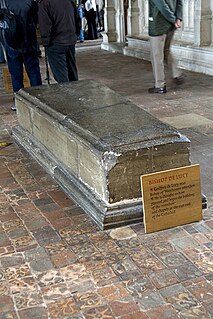
William Courtenay was Archbishop of Canterbury (1381-96), having previously been Bishop of Hereford and Bishop of London.
Nicholas of Ely was Lord Chancellor of England, Bishop of Worcester, Bishop of Winchester, and Lord High Treasurer in the 13th century.
William Alnwick was an English Catholic clergyman. He was Bishop of Norwich (1426–1436) and Bishop of Lincoln (1436–1449).
Eolla, Bishop of Selsey, was the successor of Eadberht, and seems to have previously been Abbot of Selsey, as he witnessed a charter of Noðhelm together with Osric and Eadberht. He seems to have succeeded as bishop in either 716 or 717. His date of death is sometime between 716 and 731.
Ælfred or Alfred was an Anglo-Saxon Bishop of Selsey. Ælfred attests charters from 943 to 953. In 945 he received a grant of land from Edmund I. Ælfred died between 953 and 956.

Wulfhere was Archbishop of York between 854 and 900.
Tilred of Lindisfarne was Bishop of Lindisfarne between around 915 and until his death around 925.
Wigred was appointed Bishop of Chester-le-Street around 925. He was also known as the Bishop of the Church of St Cuthbert. He attested charters of King Æthelstan between 928 and 934, and the bishopric in his time was probably the greatest landholder between the Tees and the Tyne.
Thomas Cobham was an English churchman, who was Archbishop-elect of Canterbury in 1313 and later Bishop of Worcester from 1317 to 1327.
Ralph Ergham was the English bishop of Salisbury from 1375 to 1388, and then bishop of Bath and Wells from 1388 to 1400.
Ælfric was a medieval Bishop of Hereford. He was consecrated in either 934 or between 937 and 940 and died either between 949 and 958 or in 971.

John was a medieval Bishop of Rochester.
Gilbert Glanvill or Gilbert de Glanville was a medieval Bishop of Rochester.
Benedict of Sausetun was a medieval Bishop of Rochester.
Wulfsige was a ninth-century Bishop of Sherborne.
Walter Scammel was a medieval Bishop of Salisbury.

Godfrey de Luci was a medieval Bishop of Winchester.
Ealhhun or Alhhun was a medieval Bishop of Worcester. He was consecrated between either 843 or December 844 and November 845. He died between 869 and 872.
Æthelhun was a medieval Bishop of Worcester. He was consecrated either in 915 or between 907 and 915. He died either in 922 or between 915 and 922.
Alured was a medieval Bishop of Worcester.




